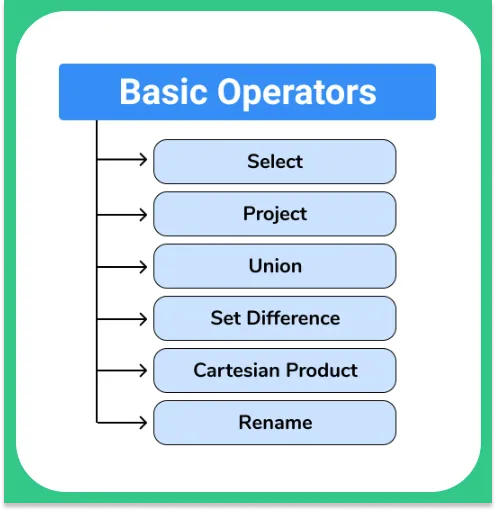Basic Operators in DBMS
Basic Operators
On this page, we will learn about the Basic Operators in DBMS. All the 6 types of Basic Operators in Relational Algebra are explained in brief.
Basic Operators in DBMS

Relational Algebra in DBMS
Relational algebrais a widely used procedural query language.- Relational algebra collects instances of relations as input and gives occurrences of relations as output by using various operations.
- Relational algebra operations are performed recursively on a relation.
- The output of relational algebra operations is a new relation, which can be formed from one or more input relations.
Basic Operators in Relational Algebra:
There are 6 basic operations in Relational Algebra. They are
Select (σ)Project (∏)Union (∪)Set Difference (-)Cartesian product (X)Rename (ρ)
Select (σ)
- The SELECT operation is used for selecting a subset of the tuples according to a given selection condition.
- This operation is denoted by symbol sigma(σ).
Syntax:
σp(r)
- σ denotes Select operation
- p denotes the condition
- r is the relation/table name
Example 1:
σ course = "Java" (Student)
Output– Selects tuples from Student where course = ‘Java’.
Example 2
σ course = "Java" and age = "20"(Student)
Output – Selects tuples from Student where the course is ‘Java’ and age is ’20’.
Example 3
σ salary > 50000 (Employee)
Output – Selects tuples from Employee where salary is greater than 50000
Projection(π)
- The projection method defines a relation that contains a vertical subset of Relation.
- It is represented by symbol pi(π)
Example:
Consider the following table:
| Stu_ID | Stu_Name | City |
|---|---|---|
| 1 | Priya | Hyderabad |
| 2 | Anjali | Mumbai |
| 3 | Rahul | Delhi |
| 4 | Rishi | Chennai |
Here, the projection of Stu_Name and City will give
Π Stu_Name,City (Students)
| Stu_Name | City |
|---|---|
| Priya | Hyderabad |
| Anjali | Mumbai |
| Rahul | Delhi |
| Rishi | Chennai |
Note:
For the next 4 operations
Consider table ‘A’ as:
| Attribute1 | Attribute2 |
|---|---|
| 1 | 1 |
| 1 | 2 |
Consider table ‘B’ as:
| Attribute1 | Attribute2 |
|---|---|
| 1 | 1 |
| 1 | 3 |
Union operation (υ)
- The operation A ∪ B includes all tuples that are in tables A or in B.
- Even if a tuple is present in both table A and table B the result will contain that tuple only once.
For a union operation to be valid, the following conditions must hold –
- A and B must have the same number of attributes.
- Attribute domains need to be compatible.
- Duplicate tuples should be automatically removed.
A ∪ B gives
| Attribute1 | Attribute2 |
|---|---|
| 1 | 1 |
| 1 | 2 |
| 1 | 3 |
Set Difference (-)
- It is represented by symbol ‘-‘ .
- Operation A – B, is a relation which includes all tuples that are in A but not in B.
For a set difference operation to be valid, the following conditions must hold –
- The attribute name of A has to match with the attribute name in B.
- The two-operand relations A and B should be either compatible or Union compatible.
Example
A-B
| Attribute1 | Attribute2 |
|---|---|
| 1 | 2 |
Cartesian product(X)
- Cartesian product is helpful to merge columns from two relations.
- This operation is meaningful only when it is followed by other operations.
Example – Cartesian product
σ Attribute 2 = '1' (A X B)
Output – The above example shows all rows from relation A and B whose Attribute 2 has value 1
| Attribute1 | Attribute2 |
|---|---|
| 1 | 1 |
| 1 | 1 |
Rename (ρ)
- Rename operation can be used to rename a relation or an attribute of a relation.
- It is represented by symbol ‘ρ’.
Syntax:
ρ(new_relation_name, old_relation_name)
Example:
ρ(Att_2, ∏(Attribute2)(B))
Output:
| Attribute2 |
|---|
| 1 |
| 3 |
Prime Course Trailer
Related Banners
Get PrepInsta Prime & get Access to all 200+ courses offered by PrepInsta in One Subscription






Login/Signup to comment